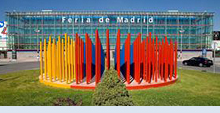 |
European Planetary Science Congress 2012
IFEMA-Feria de Madrid
23 – 28 September 2012, Madrid, Spain |
 |
|
EX2/AB1 Super-Earths and Habitability (co-organized) |
|
Oral Program
/ Wed, 26 Sep, 09:00–10:15
/ Room Venus
|
After a decade rich in giant exoplanet detections, observation techniques have reached the threshold to find and characterize planets of less than 10 Earth masses - so called Super-Earths - potentially rocky and habitable worlds.
One main goal is to inform our planetary science colleagues of the wide range of planetary science that can and is already being done with exoplanets e.g. in the field of planetary atmospheres, interiors and planetary dynamics. The session will feature a discussion on habitability and biomarkers since these are an important science driver for solar system research (e.g. Mars, Titan), but also in the field of extrasolar planets.
The detection of the first Super-Earths in April 2007 led to fundamental questions: from the influence of plate tectonics and different geochemical cycles on habitable conditions to the detectability of different biota from a remote spectrum. This number will raise significantly when Kepler planetary candidates will be confirmed. What does it take for super-Earths to support life?
Ground as well as space based telescopes to characterization rocky exoplanets, are already in development phase (E-ELT, TNT, GMT, James Webb Space Telescope). With no similar planet in our solar system, we will discuss what it take to characterize these new worlds. This session will connect theory of rocky planets and observation strategy to search for the atmospheric signatures of small exoplanets in general and for biospheres in particular.

